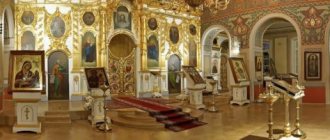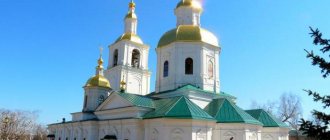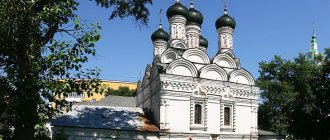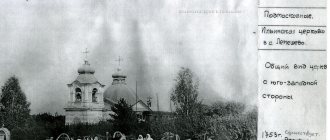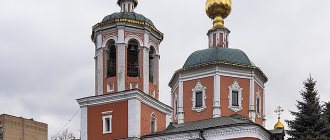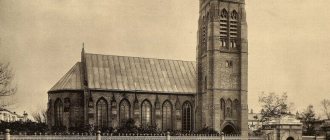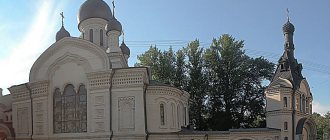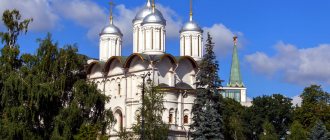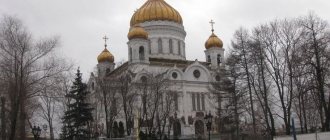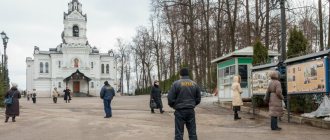Antiochian metochion in Russia
, representation of the Patriarch of Antioch to the Russian Orthodox Church
- Address: Russia, 101000, Moscow, Arkhangelsky lane, 15a
- Tel.
- On the map: Yandex.Map, Google map
Placed in Moscow on Chistye Prudy, in the churches of Gabriel the Archangel and Theodore Stratilates.
At the Ascension-Ipatievskaya Church
Patriarch Methodius of Antioch sent Metropolitan Neophytos of Iliopolis to Moscow in 1842 to collect offerings with a message in which he described the disastrous state of the Antioch Church, which suffered from Turkish oppression and Catholic propaganda. The message of Patriarch Methodius, published in the brochure “The Church of Antioch,” met with a warm response in church circles in Russia. Soon, Saint Philaret of Moscow obtained permission from the Holy Synod to transfer the Ascension-Ipatievsky assigned church in Moscow to the jurisdiction of the Patriarchal Throne of Antioch. As can be seen from the decree of the Synod, the above-mentioned church with all its utensils and church land was made an Antiochian metochion so that the funds it acquired would go to spiritual and educational work among the clergy and flock of the Antioch Patriarchate.
The metochion was granted to the Patriarchal See of Antioch in December 1848. From the same year, its first rector, Metropolitan Neophyte of Iliopolis, began to serve here. In the 1880s, during the abbotship of Archimandrite Christopher, who decided to increase the income of the monastery by building houses, the monastery received a loan from the Moscow Ecclesiastical Consistory from the sums of the Perervinsky Monastery in the amount of twenty thousand rubles. With this money, Archimandrite Christopher built stone houses at the courtyard and purchased many vestments and church utensils for the Syrian churches.
In addition to collecting donations, the metochion served as an important channel of communication between the hierarchy of the Antiochian Church and the Russian Church. Appeals and publications by the abbots of the metochion notified the Russian church society about the life of the Antiochian Patriarchate. The metochion also sent Arab students to theological schools of the Russian Church. Among the most notable abbots of the metochion during the Synodal period are St. Raphael (Avavini), the first Arab Orthodox archpastor of America; future Patriarch Alexander (Takhan); friend and confessor of Righteous John of Kronstadt, Bishop Ignatius (Aburus).
In 1929, the activities of the Antioch metochion under the Russian Orthodox Church were interrupted.
At Chistye Prudy
In 1945, it was decided to resume the activities of the Antioch Metochion in Moscow. At the beginning of 1948, with the blessing of the Patriarch of Moscow and All Rus' Alexy I, the courtyard of the Antiochian Patriarchate was located in the churches of the Archangel Gabriel and Theodore Stratilates on Chistye Prudy. The official opening of the courtyard followed on July 17 of the same year. During the Soviet period, the metochion was the only Orthodox parish in the capital, where baptisms and weddings were performed without requiring a passport or official registration of the Sacraments with the authorities. At that time, the only church children's choir in Moscow existed here, and the first Sunday school was opened.
If during the Soviet period the parish of the metochion consisted almost entirely of local Russian believers, then after the fall of the USSR a small Arab community also formed. The service was conducted in Church Slavonic and followed the customs of the Russian Church, but some customs characteristic of the Church of Antioch also took root: a children's religious procession on Palm Sunday; the rite of Burial on Good Friday, during which part of the prayers are sung in Arabic, etc.
A brief history of the Church of Antioch and its courtyard in Moscow
The Greek Orthodox Patriarchate of Antioch and the whole East is how the Antiochian Patriarchate is solemnly called in official documents. It is known that the Antiochian Orthodox Church is one of the oldest churches in the world. As the legend says, back in 37 it was founded by the Apostle Paul and the Apostle Peter.
During the existence of the church, its representatives visited Russian soil more than once to pray together with Russian Christians. There is even a book “The Journey of Patriarch Macarius of Antioch to Russia.” It tells how during the reign of Tsar Alexei Mikhailovich in Rus', Patriarch Macarius of Antioch came here twice. His own son was also with him. The boy grew up and, later becoming Archdeacon Paul of Aleppo, wrote this educational book for posterity.
During the next meeting of Russian clergy and representatives of the Antiochian Patriarchate, the guests expressed their wish for permanent representation of the Antiochian Church in Moscow.
This request did not go unanswered. And on July 17, 1948, the grand opening of the Antioch Patriarchal Metochion, the only one in Moscow, took place. At the end of the 19th century, the metochion was located in the Church of Hypatius of Gangra in Moscow's Kitay-Gorod. But later this church was demolished.
Currently, the representation of the Antioch Church is located in the Church of the Archangel Gabriel, which we know as the Menshikov Tower, and the Church of Theodore Stratelates. Its rector is Metropolitan Niphon (Saikali) of Philippopolis.
Abbots
- Neophyte (December 1848 - December 3, 1853)
- Anfim (1853 - 1861)
- Gabriel (Satula) (1862 - 1869)
- Kirill (1871 - 1873)
- Isaiah
- Eutychian
- Peter
- Christopher (Jibara) (1879 - 1887) [1]
- St. Raphael (Avavini) (1889 - 1893)
- Alexander (Tahan) (April 20, 1900 - November 30, 1903)
- Ignatius (Aburus) (November 1903 - mentioned 1908)
- Anthony (Mubayar) (1910 - 1929)
- Vasily (Samakha) (July 1948 - 1962)
- Alexy (Abdel-Karim) (1962 - 1971)
- Macarius (Tayyar) (1971 - 1977)
- Niphon (Saikali) (since May 9, 1977)
Inactive from 1929 to 1948
Two churches on Chistye Prudy
Gabriel's Church was built in 1707 by order of His Holiness Prince A.D. Menshikov, friend and comrade-in-arms of the Russian Tsar Peter 1.
It was in the building of this ancient and very beautiful landmark of Moscow that a significant event took place in a solemn atmosphere in 1947: the transfer of two neighboring churches to the Antioch courtyard. The delegation from the Antiochian Orthodox Church included priests and other representatives of the clergy, and was headed by Metropolitan Alexander of Emesa.
For more information about the tragic history of this amazingly beautiful church, which is popularly called the Menshikov Tower, about the man - a friend of Peter the Great, in whose honor this name was assigned to it, about the architects and creators, read the article: “Church of the Archangel Gabriel on Chistye Prudy: Menshikov tower".
The second church, belonging to the courtyard of the Antiochian Patriarchate - the Temple of Theodore Stratilates in Moscow - is no less interesting for its history, loved and visited by Muscovites and visiting tourists.
The history of this temple began in 1806. Funds for its construction were allocated by the director of the nearby post office F.P. Klyucharyov. The Stratilat Temple was built according to the design of the then famous architect I.V. Egotova. In 1812, after a terrible fire that happened in Moscow, this talented man was appointed chief architect for the restoration of Moscow buildings. And thus he became the founder of the church on Chistye Prudy.
His famous creations are known as the old building of the Armory Chamber, the tomb of the princely family of Golitsyn in the Donskoy Monastery. Ivan Vasilyevich Egotov participated in the restoration and restoration of the walls and towers of the Moscow Kremlin, and took part in the construction of the Catherine Palace in Lefortovo.
MENSHIKOV TOWER (TEMPLE OF THE ARCHANGEL GABRIEL AT CHISTYE PRUDI). ANTIOCH COMPOUND
“Sukharev Tower is the bride of Ivan the Great, and Menshikova is his sister.”
Until the beginning of the 18th century, on the site of the current Menshikov Tower there was a small church of the Archangel Gabriel, “at the Myasnitsky Gate,” known since the 16th century. Its name can be associated with the second, Christian name of Grand Duke Vasily III, father of Ivan the Terrible - Gabriel.
In 1704, His Serene Highness Prince Alexander Danilovich Menshikov was a parishioner of the church. Returning from one campaign, he brought an ancient icon of the Mother of God that he had bought in Polotsk, according to legend, painted by the Evangelist Luke himself, and wished to build a new temple for it on the site of the old church.
In these places there passes Myasnitskaya Street, which at the end of the 16th century was cut by the fortress wall of the White City, and the Myasnitsky Gate was built at the intersection. The name of the street and the fortress gate comes from the butchers' settlement located outside the city walls.
And inside the city, next to the gates, in 1699, A.D. Menshikov, a friend and ally of Peter I, bought the estate. This was before the founding of the city of St. Petersburg, so Menshikov intended to settle in the Moscow estate for a long time.
The butchers also did not intend to move anywhere and continued to do their job, and the production waste was dumped into a pond located nearby. This pond exuded a bad smell, which is why Muscovites received the dissonant name “Filthy” pond.
And why was it necessary to buy land in such an unfortunate place? The matter was in Myasnitskaya, along which at that time one of the roads to the German Settlement passed, where Peter I often visited and Alexander Danilovich, being a resourceful man, did not fail to take advantage of this. Having bought the estate, Menshikov ordered the cleansing of the Pogany Pond, which has since been called Clean, and even in the plural.
Construction of the Menshikov Tower began in 1704 and ended three years later. The photo below is not mine, it was taken from one of the windows of the Moscow Post Office.
The construction of the new Temple of the Archangel Gabriel was entrusted to the architect Ivan Zarudny and his subordinate, the European master Domenico Trezzini. True, the latter was sent to St. Petersburg six months later, where eight years later he founded the Peter and Paul Cathedral. The Menshikov Tower is considered the prototype of the cathedral.
By 1707 the temple was structurally completed. Initially, the tower had four tiers and a height of 84.2 meters, which exceeded the height of the Ivan the Great Bell Tower in the Kremlin by three meters. This caused discontent among native Muscovites, who did not particularly like Alexander Danilovich.
Before the fire of 1723, the tower ended with a high spire, topped with a weather vane in the form of a figure of a soaring angel with a cross in his hand. This is how she is depicted in an engraving by A. Zubov from 1711, depicting the triumphal entry into Moscow after the Battle of Poltava of Peter I with generals, troops and numerous prisoners.
The Menshikov Tower, at first glance, has little in common with previous Russian architecture, but in fact it is its own flesh and blood. Essentially, this is a traditional tower church “like the bells.”
To facilitate the construction, the upper tier was made of wood. In 1708, a clock with chimes, imported from England, was placed on the upper tier of the temple. The chimes struck the hour, half hour and quarter hour, and at noon all fifty tower bells rang and shimmered for half an hour, delighting the ears of the townspeople.
The tower was decorated with an unprecedented abundance of stone sculpture. Garlands of flowers and fruits, vases, cornices - all this gives the tower lightness despite its considerable size. Kostroma and Yaroslavl craftsmen, who have long been famous as skilled stone carvers, worked on decorating the church.
After Menshikov left for St. Petersburg, funding for the temple stopped. It began to quickly deteriorate. Ivan Zarudny warned the prince about the possible consequences of the devastation, but Alexander Danilovich had already lost interest in his brainchild.
In 1723, a great fire occurred in the Temple of the Archangel Gabriel.
On June 14, the day of the funeral service for the priest who died the day before during evening prayer within the walls of the church, a thunderstorm came and lightning struck directly on the cross. The dome of the structure caught fire first. Then the fire engulfed the wooden part, causing the domes attached there to begin to crumble and break the vaults of the church. Many people who tried to remove various valuables from the building engulfed in fire died in this disaster.
The building stood in this form for more than fifty years. Everyone had already forgotten that it was a church, and the dilapidated structure was simply called the Menshikov Tower.
In 1787, Gabriel Izmailov, who lived nearby on Myasnitskaya Street, undertook to restore the church. During the restoration of the church, instead of the upper tier with a 30-meter spire, a rounded dome with a screw spire was made. The temple acquired special features and its current appearance: the dome was designed in the form of a helical candle, the upper octagon was replaced with a baroque dome, the sculptures at the corners of the lower octagon were replaced with vases. In addition, the external and internal walls of the Temple were decorated with Masonic inscriptions, symbols and emblems.
All this greatly changed the appearance of the Tower. The sharpness that the high spire gave it, as if “piercing” the sky, was gone. The tower acquired a rounded shape and “softness”. And this despite the fact that the Tower remained the tallest church in Moscow. After reconstruction, the church became a universal favorite of Muscovites.
The bells did not return to the tower. A new church was built nearby for them - in the name of Theodore Stratilates. These two temples are related as Baroque and Classicism. The dedication of the church to Saint Theodore is apparently due to the fact that the Moscow postal director bore the name Fedor - Fedor Petrovich Klyucharyov, an actual privy councilor, senator. A prominent figure in Russian Freemasonry, author of mystical and religious poems.
Almost nothing is known about G.Z. Izmailovo. Sources mention that he was from a wealthy family and owned a house located on the site of house 19 on Myasnitskaya Street. That's all. Meanwhile, after reconstruction, the Menshikov Tower should rather be called the Izmailov Tower.
Gabriel Izmailov belonged to the then existing lodge of Masons in Moscow, who called themselves Martinists. In Krivokolenny Lane, not far from the Church of the Archangel Gabriel, about fifty students of the Pedagogical Seminary, organized by the Masons, lived in the house of Professor Schwartz. It was for them that Izmailov restored the Church of the Archangel Gabriel, decorating it inside and out with Masonic symbols and emblems with Latin inscriptions.
For a long time, the authorities looked condescendingly at the existence of Masonic lodges in the country. Catherine II believed that this was just a harmless passion for mystical teachings. Everything changed when the Moscow Masons were caught in a secret connection with the Prussian court, hostile to Russia. From the decrypted secret correspondence it was clear that the “champions of enlightenment” were preparing a coup d’etat. As a result, Novikov and several other masons were arrested and imprisoned in the Shlisselburg fortress.
However, the secret signs that decorated the walls of the Menshikov Tower existed for several more decades. In 1852, Metropolitan Philaret (1782-1867) suddenly remembered the Masonic signs and Latin inscriptions and ordered them all to be destroyed. They were in no hurry to fulfill the Metropolitan’s demand. The inscriptions and symbols were partially replaced or knocked down only in 1863. What remained was a spire that looked like a candle flame, and vases that replaced the burnt white stone angels. They couldn’t get to them or didn’t want to. Figures remain above the southern entrance, holding scrolls with erased inscriptions.
The numerous sculptural decorations that have come down to us are not just modeling or carving, they are “story sculptures” on evangelical themes, perhaps the first in the Moscow tradition.
In 1792, a post office was located in the building of the estate of Alexander Menshikov, to which the Menshikov Tower was also assigned. Until the end of the nineteenth century, the church was considered departmental and was called the “Temple of the Archangel Gabriel at the Post Office.” Only due to the lack of money from the postal department to maintain the church, it became a parish.
The post office and other buildings blocked the Menshikov Tower so much that now a rare passer-by, not knowing about its existence, being nearby, will guess that in the depths of the block there is a temple, rivaling in height the Spasskaya Tower of the Kremlin, and once challenging the very bell tower of Ivan the Great.
The temple was closed for worship in the 30s of the twentieth century. In 1945, at the Local Council of the Russian Orthodox Church, it was decided to restore the Antioch metochion. This was connected with the arrival of Alexander III, Patriarch of Antioch, at the Council.
Finally, for lovers of mysticism, a few facts. If we look at the map of Moscow as it developed after Peter the Great, when the Petrovskaya Yauza square was added to the round Kremlin Moscow, and put a ruler between its most distant outposts, Luzhnetskaya and Preobrazhenskaya, the center of Moscow will turn out to be the Myasnitsky Gate.
Moreover, the Menshikov Tower was located near the top of Sretensky Hill, the highest hill in Moscow, higher than the Kremlin Hill. Here, near the post office, was then the “zero kilometer”, the beginning of all Russian roads. And at the beginning of World War II, military control was carried out not from the Kremlin, but from the dungeons of the Kirovskaya metro station, now Chistye Prudy.
Briefly about Theodore Stratelates
Initially, the Stratilat Church was conceived as a bell tower at the St. Gabriel Church and was consecrated in the name of Fyodor Tiron. Later, with money donated by the director of the post office, Klyucharyov, a chapel was added to it in the name of Theodore Stratelates, and then the entire temple was re-consecrated and began to be called Stratilatovsky.
Sometimes Theodore Stratelates and Theodore Tyrone are confused due to the similarity of their life stories and some nuances in the translation of Greek texts. This is not surprising, because both of these saints were born and lived in the same area at almost the same time, both killed huge snakes with God’s help, saving people, and both are considered patrons of warriors. But, nevertheless, these are two completely different people, as evidenced even by the translation: Stratilates is translated as “military manager”, and Tyrone means “recruit”.
To put it more or less briefly, Fyodor Stratelates served in the imperial army. After he alone and prayerfully killed a huge serpent that was devouring people and animals in the name of Jesus Christ, Theodore was appointed military commander (this word in Greek means “stratilate”) to the ancient Greek city of Heraclea.
There he did not stop preaching the Gospel, glorifying the name of Jesus. Seeing before them the impeccable example of the ardent faith of the stratilate (which means the military leader) Theodore, many in those days converted to Christianity.
At this time, Emperor Licinius ruled the country. Fiercely hating the new faith, he began persecuting Christians and decided to start with those who had authority among people. Having heard about Theodore, he called him to his palace. But Theodore Stratilates replied that he could not leave military service, since the situation did not allow him to leave. He, in turn, invited the emperor to his house, promising to make a sacrifice to the pagan gods.
Licinius agreed. Then Theodore collected all the gold and silver statues of pagan gods that he could find in his city, broke them and distributed the fragments to everyone in need.
Having learned about this, Licinius became furious. On his orders, Theodore was captured and severely tortured. After this, the emperor's soldiers crucified his tortured body on a cross and left it there overnight. At night, the Lord made sure that Theodore’s body was completely healed, and he was able to come down from the cross.
In the morning, the inhabitants of Heraclea saw the saint alive and unharmed. This became for them another proof of the omnipotence of the Christian God. The frightened Emperor Licinius, seeing the Great Martyr. Theodora, alive and without a single scratch on his body, ordered him to be captured and executed: to cut off his head. Which is what happened on February 8, 319.
External description of the Church of the Great Martyr. Theodora
Let's return to the history of the temple in the name of this saint. At the beginning of the 19th century, the temple of the Holy Great Martyr Theodore Stratilates was built right in front of the Menshikov Tower. Both churches are located very close to each other and at a quick glance it seems that they are even similar. Although the St. Gabriel Church was built in the Baroque style, and the Temple of Theodore Stratelates was built in the Classicist style.
From the very beginning, the project of the Gabriel Church did not provide for the construction of stoves in the building. Heating such a large and tall building would be problematic. Unlike the Menshikov Tower, the small temple of Theodore Stratilates on Chistye Prudy was heated, and, with its appearance, in winter services were held there.
An interesting fact is that both churches suffered almost no damage during the terrible fire of 1812 during the invasion of Napoleon. There is a legend according to which F.P. Klyucharyov, the director of the post office, paid the French soldiers, and they only pretended that they wanted to set fire to the churches. In fact, by agreement with the director of the post office, they never did this.
In the 60s of the 19th century, another chapel appeared at the church. It was consecrated in the name of the icon of the Mother of God “Unexpected Joy”.
The Church of Theodore Stratilates at the Antioch Compound harmoniously fits into the ensemble of the lane. The lower floor of the building stretches along the street, a wide dome, beautiful windows created in the shape of an arch. And all this beauty, like a cherry on the cake, is still crowned to this day by a neat, slender bell tower with bells inside.
After the revolution of 1917, the Church of Fyodor Stratilates continued to operate. Its closure occurred in 1930 along with the cessation of services in the Menshikov Tower. The building and interior decoration of the temple were preserved. The only thing was that the four-column portico had to be dismantled, which interfered with the movement of vehicles along the alley. You can compare in the photograph the architectural appearance of the temple with a difference of 1.5 centuries: 1881 and 2021.
And almost immediately after the war in 1947, as was already written above, with the blessing of His Holiness Patriarch Alexy 1, the Antioch metochion in Moscow was located here, and regular services began to be held again.
History[edit]
The temple was erected at the turn of the 18th and 19th centuries as a winter (that is, heated, used in the cold season) church at the Church of the Archangel Gabriel. For a long time, the small church was called the post office church, as it was located next to the Moscow post office. The temple was not damaged in the war with Napoleon and in the great Moscow fire of 1812. According to eyewitnesses, French soldiers threw burning straw around him just for show. Initially, the temple was consecrated in honor of St. Theodore Tyrone; soon, with donations from the local postal director, a chapel of St. Theodore Stratilates was built in it. At the end of the 19th century, a chapel appeared in the temple in honor of the icon of the Mother of God “Unexpected Joy”, and the main altar was the altar dedicated to Theodore Stratelates. According to him, the temple received a new name.
Shrines of the Stratilat Church
The interior of the church is also very beautiful. The beautiful iconostasis and paintings from the second half of the 19th century have been preserved.
There are many icons in the church. The main shrine of this temple is the miraculous icon of the Mother of God “Unexpected Joy”. Among the rarities of the church is an icon of the holy venerable elders of Optina with pieces of relics, as well as 2 relics in which particles of the relics of many saints are collected. Such, for example, as Sergius of Radonezh, the holy healer Panteleimon, Matrona of Moscow and many others.
There is silence and tranquility inside the temple. There are usually few people in the church, unless, of course, it is February 21, when the patronal feast of the temple is celebrated - the Day of Remembrance of Theodore Stratelates. On this day, more people come to the Services than always. According to tradition, Divine services are held in Church Slavonic.
In front of the icon of the saint, people read prayers and akathists. Theodore Stratilates helps those who turn to him to maintain peace in the family or resolve a conflict with any person, protects them from enemies, both visible and invisible. They pray to the patron saint of warriors, Theodore Stratelates, for the safe return home of soldiers in military service and for their preservation of life and health.
The name day of Fyodor Stratelates is also celebrated on June 21.
Street where attractions live
Houses that tell stories
In general, Arkhangelsky Lane is interesting not only for these sights. During its entire existence, it changed its name four times. At first it was Kotelnikov Lane, as boiler makers lived there. Then the names changed quite often: Gavriilov, Menshikov, Telegraph Lane. And now Arkhangelsky.
Its length is small - only about 500 meters. But some of the buildings located here are associated with famous people of their time. So, for example, at the very beginning of the street there is a house (at number 1), which faces 3 lanes at once: Arkhangelsky, Sverchkov and Armyansky. Our famous writer Yuri Nagibin lived there at one time. A memorial plaque dedicated to him recently appeared on the wall of the house.
Revolutionary Pavel Dauge lived in house number 7, built in 1907. In the fall of 1913, Vladimir Ulyanov (Lenin) visited here.
The history of house No. 13 on Arkhangelsky Lane is interesting: the Frolov-Bari residential building. Now it is a 5-story building.
But it can be discerned that its base is a 2-story mansion, on top of which only later, in the 1940s, additional 3 floors with bay windows and balconies were built.
The house was originally built in 1836. In 1884, it was purchased by the family of the merchant Frolov. In 1902, the famous entrepreneur Alexander Bari became the owner of the mansion. In 1918 the house was nationalized. And in 1918-1934, the unique scientist, engineer and inventor Vladimir Grigorievich Shukhov lived and worked in this building. Yes, yes, the same creator of the Shukhov Tower.
This house number 13 in Arkhangelsky lane. recognized as a historical and cultural monument, as evidenced by a special plaque. It is located on the side of the house from Krivokolenny Lane.
Near the Temple of the Archangel Gabriel, the street development with residential buildings is so dense that it seems as if there is no passage between them. But each house has its own long history.
Next to the Menshikov Tower is the Temple of Theodore Stratilates. There is also a two-story house with a mezzanine. This is the clergy house, for the servants of this temple. True, now the Menshikov boutique hotel is located here. I don’t know, maybe he somehow shares premises with the church clergy. Or it completely occupies the entire room.
Princess Charity
And I would like to talk about one more building in Arkhangelsky Lane in more detail. The house at number 17 once housed an orphanage for children from poor families. This ornate red brick building, similar to a two-story Russian tower, was built in 1892.
Within its walls there used to be an orphanage for the Elizabethan Charitable Society. Its founder and main trustee was the then 28-year-old Grand Duchess Elizaveta Feodorovna (canonized after her death).
The grand opening of the shelter took place in the personal presence of the Grand Duchess. The charter of this charitable society was signed by the Emperor of the Russian State, Alexander 3.
Following the example of the orphanage in Arkhangelsky Lane, the same charitable organizations began to appear in other church parishes in Moscow. Soon the number of such charitable committees to help children reached 238.
However, none of them were funded by the state. All organizations existed through donations, fees from concerts, performances, and membership fees. Elizaveta Fedorovna herself donated more than 60 thousand rubles from her personal money to the fund for poor children.
The Elizabethan Charitable Society worked for 25 years, until the revolution of 1917. During this time, according to archival documents, this organization provided financial assistance to widows left with children without husband support in the amount of 120 thousand rubles, 6 thousand children lived in shelters and approximately 4 thousand children received benefits. In total, the Elizabethan community spent more than a million rubles on charitable purposes.
Now service to people continues in the building: a clinic (children's department) is currently open there. And above the red-brick building of the shelter, decorated in neo-Russian style, rises the beautiful Tower, which is popularly called Menshikova. And on the left in the photo you can see a piece of the bell tower of the Temple of Fyodor Stratelates, which was discussed in this article.
Here is a relatively small side street in Moscow - Arkhangelsky. And how many amazing and educational stories are connected with it!
History of the construction of the Menshikov Tower
For the first time, the “Church of Gabriel the Archangel in Myasniki” was mentioned in documents from 1551. In the 2nd half of the 17th century it was rebuilt in stone. In 1699, the property north of it was bought by the Tsar’s associate, Alexander Danilovich Menshikov.
A manor house was built on the site of the current Post Office. In 1704, construction began on the current temple, which was completed in 1707. The Menshikov Tower amazed with its height (81 meters) and the splendor of its decoration. Domestic and foreign masters took part in its creation, among whom were I.P. Zarudny, Trezzini, Fontana, etc. In 1708, a clock of English work with chimes was installed. Fifty bells were hung on the bell tower. The Menshikov Tower was crowned by a thirty-meter spire with a gilded angel.
Probably, the architect I.P. Zarudny is also the author of the completion of the chambers of the Duma clerk Averky Kirillov in Moscow.
After Menshikov became governor-general of St. Petersburg in 1710 and began arranging his palace there, work on the interior decoration of the temple slowed down.
♦ On topic: Menshikov Palace in St. Petersburg
Reconstruction of the original appearance of the Menshikov Tower
In 1723, a fire broke out from lightning striking the spire of the Menshikov Tower. The wooden top was destroyed, the bells broke through the vaults, the English clock was destroyed, and the interior decoration of the temple, which was nearing completion, was seriously damaged.
In 1773-1779, the Menshikov Tower was restored, the vaults of the central part were re-erected, and the bell openings were laid. White stone vases were placed in place of the statues. In 1821, the Church of the Archangel Gabriel became a “post office” church, and in the middle of the same century - a parish church.
During the restoration of 1830, it was supposed to open the bells, but this was never done. At the same time, the current dome with a cross was erected. In the 1960s, an iconostasis from the late 19th century was moved here from the dismantled Church of Peter and Paul in Preobrazhenskaya Sloboda.
Menshikov Tower in the middle of the 19th century
Menshikov Tower, photo from 1881
the Church of Fyodor Stratelates was erected as a winter temple “under the bells” . The project is attributed to I.V. Egotov. Since 1821, the Fedorovskaya Church also became a post office. At the end of the 19th and beginning of the 20th centuries, multi-storey apartment buildings began to be built in the surrounding alleys and on Myasnitskaya Street, and the beautiful tower was closed by them.
Menshikov Tower and Church of Fyodor Stratelates, photo from Soviet times
Church of Fyodor Stratelates and the Temple of the Archangel Gabriel (Menshikov Tower)
Main section of the Menshikov Tower
Menshikov Tower in Moscow
Menshikov Tower in Moscow
Alas, you can’t take pictures inside, although the structure is truly unique, and it’s a shame that I can’t show this beauty.
We study the route and schedule of the temple
The Temple of Theodore Stratelates is open to the public every day from Monday to Friday from 7:30 to 12 and from 17:30 to 20. Schedule of Divine services: on weekdays they take place at 8 and 18 o'clock. On Sundays and holidays - at 7:30 and at 18. On Saturdays and days before holidays, Services are performed at 18 o'clock in the neighboring Church of the Archangel Gabriel of the Antioch Patriarchal Metochion.
At 18:00 every Sunday in the Church of St. Vmch. Theodore Stratelates reads an akathist to the icon of the Mother of God “Unexpected Joy”.
The Church in the name of Fyodor Stratelates is located next to Chistye Prudy at the address: Moscow, Arkhangelsky Lane, 15A, building 2.
The Feodorovskaya and Gabrielovskaya churches of the Antioch courtyard, all other attractions of Arkhangelsky Lane can be seen by walking just 200 meters from the Chistye Prudy metro station or 300 meters from the Turgenevskaya metro station. Alternative option: buses 122, 144 or trams No. 3, No. 39.
The church is located right next to the road, it is clearly visible. In the courtyard there is the Menshikov Tower. But to see it, you need to look carefully inside the yard. Despite its colossal height, it is not easy to see it behind modern buildings. Have a nice experience!
Coordinates of the Church of Theodore Stratelates at the Antioch Metochion in Moscow: 55.76295, 37.63919.
On the map you can determine the exact location of the Temple of Theodore Stratilates on Chistye Prudy and the surrounding attractions (click “+” or “-” to zoom in or out of the image).
To stay in Moscow for a few days, you can easily rent an apartment or room on Airbnb, or book a hotel in any convenient location in the city through Booking.
For example, you can stay at the cozy boutique hotel "Menshikov", which is located directly next to the courtyard of the Patriarch of Antioch. And then from your own windows you will be able to admire the beautiful tower and bell tower of the ancient temple. How do you like the idea of waking up in the morning with a view like this?
I visited the courtyard of the Antiochian Orthodox Church in Moscow on July 17, 2021. There are many historical and modern buildings located along Chistye Prudy; it is so nice to take a leisurely stroll in this area, immersing yourself in the history of Moscow.
From here you can walk, for example, to Sukharevskaya Square (this is about 1.5 kilometers). Now there is Sukharevsky Square, and previously this place was the location of the legendary Sukharev Tower. And on the way, be sure to take a look at the unique ancient church of St. Nicholas of Myra in Derbenev.
The map below shows other attractions of Moscow and the Moscow region that I was able to visit.
Share in the comments below which unusual temples you have visited and which of them made the greatest impression.

